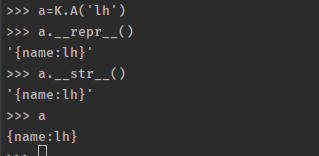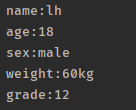这里写目录标题
我的python版本 3.8,不同版本的python可能有影响。
一切皆对象
验证函数和类都是对象。
思路:定义一个函数和类,使用isinstance()函数来判断函数和类是否是对象。
def func(): #定义一个函数
return None
class Func(): #定义一个类
def __init__(self,name='xxx'):
self.name = name
def func_demo(self): #定义实例的方法
print(self.name)
return self.name
if __name__ == '__main__':
my_func=func
print(isinstance(my_func,object)) #True
my_Func=Func()
print(isinstance(my_Func,object)) #True
print(isinstance(my_Func.func_demo,object)) #True
魔法方法__getitem__
#__getitem__使对象实现迭代功能。
a = ['我','与','秋','风','皆','过','客']
class A(object):
def __init__(self,args):
self.list = args
def __getitem__(self, item):
print(item)
return self.list[item]
li=A(a)
for i in li:
print(i)
魔法方法之__str__和__repr__
- __repr__和__str__这两个方法都是用于显示的,__str__是面向用户的,而__repr__面向程序员。
class A(object):
def __init__(self,name):
self.name=name
a=A('lh')
print(a)
print(a.__repr__())
print(a.__str__())

我们发现__repr__和__str__返回的都是对象所在的内存地址,这时我们需要对__repr__和__str__重写。
#重写__repr__方法
class A(object):
def __init__(self,name):
self.name=name
def __repr__(self):
return "{name:%s}" %self.name

#重写__str__方法
class A(object):
def __init__(self,name):
self.name=name
def __str__(self):
return "{name:%s}" %self.name
a=A('lh')

多态
- extend方法
a = [1,2,3]
b = {4,5}
c= (6,7)
a.extend(b)
print(a)
a.extend(c)
print(a)
#[1, 2, 3, 4, 5]
#[1, 2, 3, 4, 5, 6, 7]
- 不同类的同种方法调用
class Dog(object):
def eat(self):
print('狗吃狗粮')
class Cat(object):
def eat(self):
print('猫吃猫粮')
class Fish(object):
def eat(self):
print('鱼吃饵料')
animals= [Dog,Cat,Fish]
for animal in animals:
animal().eat()
#狗吃狗粮
#猫吃猫粮
#鱼吃饵料
type与isinstance
type和isinstance都是判断对象的类型,不同的是type判断对象类型时不会考虑继承关系,而isinstance判断对象的类型时会考虑继承关系。
class A(object):
pass
class B(A):
pass
a = A()
b = B()
print(type(a) is A) #True
print(type(b) is B) #True
print(type(b) is A) #False
print(isinstance(a,A)) #True
print(isinstance(b,B)) #True
print(isinstance(b,A)) #True
类属性与实例属性
#@Time : 2020/12/12下午 01:55
#@Author : Anthony.l
#@File :instance_attribute-and-class_attribute.py
#@Software :PyCharm
class A(object):
title1 = '这是类属性'
def __init__(self):
self.title2 = '这是实例属性'
class B(A):
pass
a = A()
b = B()
print(a.title1)
print(a.title2)
print('~~~~~~~~~~')
print(b.title1)
print(b.title2)
print('~~~~~~~~~~~')
print(A.title1)
# print(A.title2)
#这是类属性
#这是实例属性
#~~~~~~~~~~
#这是类属性
#这是实例属性
#~~~~~~~~~~~
#这是类属性
我们发现当实例没有属性时会向上类中去搜寻属性,若类中没有属性则会报错;但是类中没有属性,不会向下寻找属性,而是直接报错。
继承的拓展
类的继承,有两种算法:
1、深度优先搜索DFS
class A(object):
pass
class B(object):
pass
class C(A):
pass
class D(B):
pass
class E(C,D):
pass
print(E.__mro__)
#(<class '__main__.E'>, <class '__main__.C'>, <class '__main__.A'>, <class '__main__.D'>, <class '__main__.B'>, <class 'object'>)
2.广度优先搜索BFS
class A(object):
pass
class B(A):
pass
class C(A):
pass
class D(B,C):
pass
print(D.__mro__)
#(<class '__main__.E'>, <class '__main__.D'>, <class '__main__.B'>, <class '__main__.A'>, <class 'object'>)
实例方法、类方法与静态方法
class Data(object):
def __init__(self,year,month,day):
self.year = year
self.month = month
self.day = day
#实例方法
def tomorrow(self):
self.day += 1
#静态方法
@staticmethod
def parse_from_string(data):
year, month, day = data.split('-')
return (int(year),int(month),int(day))
#类方法
@classmethod
def get_day(cls,data):
year, month, day = data.split('-')
return cls(int(year), int(month), int(day))
#重写repr方法
def __repr__(self):
return "%s %s %s" %(self.year,self.month,self.day)
if __name__ == '__main__':
day = Data(2020,12,12)
print(day.tomorrow()) #调用实例方法
date = '2020-12-12'
print(Data.parse_from_string(date)) #调用静态方法
print(Data.get_day(date)) #调用类方法
super函数
获取父类的属性
class Person(object):
def __init__(self,name,age,sex,weight):
self.name = name
self.age = age
self.sex = sex
self.weight = weight
class Student(Person):
def __init__(self,name,age,sex,weight,grade):
super().__init__(name,age,sex,weight)
self.grade = grade
def __repr__(self):
return "name:%s\nage:%s\nsex:%s\nweight:%s\ngrade:%s"%(self.name,self.age,self.sex,self.weight,self.grade)
student=Student('lh','18','male','60kg',12)
print(student)

查看继承属性
class A(object):
def __init__(self):
print('A')
class B(A):
def __init__(self):
print('B')
super().__init__()
class C(A):
def __init__(self):
print("C")
super().__init__()
class D(B,C):
def __int__(self):
print("D")
super().__init__()
print(D.__mro__)
#D->B->C->A 广度优先搜索BFS
自省
-
计算机编程中,自省是指这种能力:检查某些事物以确定它是什么、它知道什么以及它能做什么。自省向程序员提供了极大的灵活性和控制力。
-
Python中比较常见的自省(introspection)机制(函数用法)有: dir(),type(), hasattr(), isinstance(),通过这些函数,我们能够在程序运行时得知对象的类型,判断对象是否存在某个属性,访问对象的属性。
-
dir()
- 返回传递给它的任何对象的属性名称经过排序的列表。
class A(): pass print(dir(A)) #['__class__', '__delattr__', '__dict__', '__dir__', '__doc__', '__eq__', '__format__', '__ge__', '__getattribute__', '__gt__', '__hash__', '__init__', '__init_subclass__', '__le__', '__lt__', '__module__', '__ne__', '__new__', '__reduce__', '__reduce_ex__', '__repr__', '__setattr__', '__sizeof__', '__str__', '__subclasshook__', '__weakref__'] -
type()
- 通过返回类型对象来确定对象是字符串还是整数,或是其它类型的对象.
print(type(11))
#<class 'int'>
- hasattr()
- 测试一个或多个属性是否存在.
- isinstance()
- 测试对象,以确定它是否是某个特定类型或定制类的实例。






















 1万+
1万+











 被折叠的 条评论
为什么被折叠?
被折叠的 条评论
为什么被折叠?








